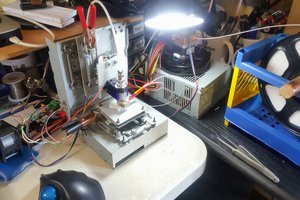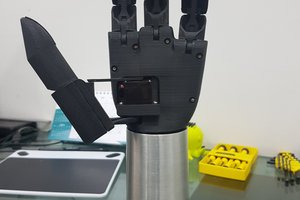ProtoCycler was started to solve the problem of 3D printing being unsustainable. Between the cost of new filament and the waste generated, we weren't able to fully exploit it's potential! We're firm believers that 3D printing can change the world - but that's only going to happen if it's accessible to everyone, and doesn't contribute to the plastic waste in the world.
We first started ProtoCycler quite a few years ago, right around the time the first extruders (Lymann, Filabot, Filastruder, etc) came to be. We were disappointed by the lack of reliability and performance anyone else offered, and spent over a year trying to perfect that basic design - but no matter what we tried, you had to be a plastics master to get anything usable to come out, and even then the slightest problem would result in a roll of waste, instead of a roll of printable filament! Plus, none of them came with a grinder, or a spooler...so actually converting garbage into filament was a pretty labour intensive process.
We decided to create a machine that would change all of that, a tool that would do literally everything from grind the waste to spread it evenly on the spool of your choosing. It was very important to us that ProtoCycler could be fully automatic and hassle free - because some people just want their tools to work, so they can use them to make other awesome stuff - but it also had to be fully hack-able, so that anyone could modify it to their hearts content.
So how does it work? The grinder section is pretty simple - two really strong toothed wheels bite into the plastic and take little chunks out of it. If you search for shredding videos on youtube, you'll get the idea! The extruder is a lot more complicated. Some key discoveries along the way were that shrinking down industrial scale tech just wouldn't work, and that making an extruder "smart" is incredibly valuable. That's why ProtoCycler features MixFlow technology, to get some of the most consistent extrusion available, as well as a real-time diameter feedback loop, to ensure that nothing ever messes up. In total, ProtoCycler has 5 motors (2 steppers for extruding and pulling, a fan for cooling, a servo for spreading, and a small little motor for spooling) and 3 sensors (1 temp and two diameter) to accomplish it's job reliably. The ground up waste or raw plastic pellets start their journey in the hopper. From there, they're pressurized by the auger/stator assembly. They then leave the auger behind and enter the hot section, where MixFlow mixes and melts them until they're a uniformly goey mess of molten plastic perfection ;). After passing through some filters to make sure you don't get any bad stuff in your filament, the plastic exits the nozzle, where it immediately gets measured by diameter sensor #1. It's then cooled fully, re measured by sensor #2, and finally passes through the puller. The puller adjusts it's speed constantly to ensure the diameter is always perfect, based on the readings of the two diameter sensors and some heavily modified PID algorithms. Last but not least, the filament passes through a servo controlled spreader arm, and onto a spool. All of this happens automatically, and quite quickly - it's easy to get over 5 ft per minute with 1.75mm PLA and, if you can believe it, over 10 ft/min with 1.75mm ABS (cooling is the major limiting factor, and anyone who's 3D printed knows PLA needs to be cooled way more than ABS!). As an added bonus, the energy used to do all of this is only about 60 watts - significantly less than any other extruder, especially when the speed is taken into account.
It's pretty awesome to run ProtoCycler automatically, because you can go off and make stuff while it makes you more filament (which you can use to make even more stuff, while it makes you even more spools to make even more stuff, etc etc). But tinkering and hacking are key to making - after all, this IS Hackaday! - and so anyone can hack into ProtoCycler, even if they've never touched C++...
Read more »



 AccidentalRebel
AccidentalRebel
 Christine
Christine
 Jesús Tamez-Duque
Jesús Tamez-Duque
 Giovanni Leal
Giovanni Leal
Hello Hackaday IO can you please remove this or add the caveat that they have not delivered to original indiegogo backers or pre-order buyers (such as myself). HackadayIO failure to add a caveat or delete the story makes it complicit in the theft and scam being perpetrated by Redetec 3d and Dennon Oosterman. Post like this continue to drive unsuspecting buyers to Redetec3D only to be scammed, in the end fighting for their money back. A number of reports like this on the BBB Ontario website